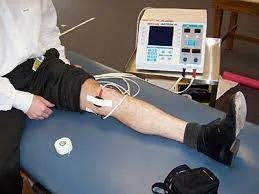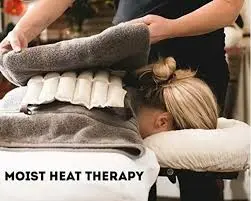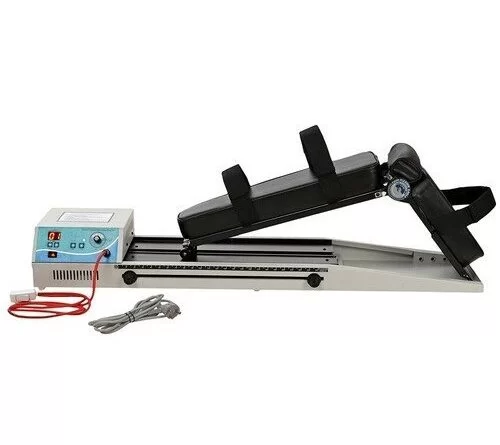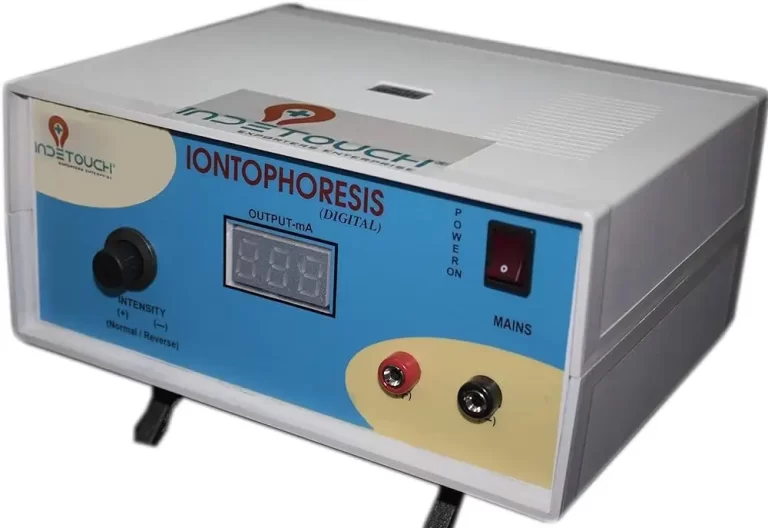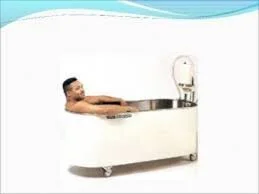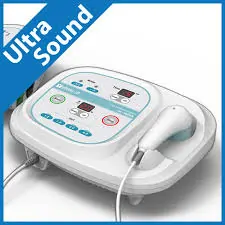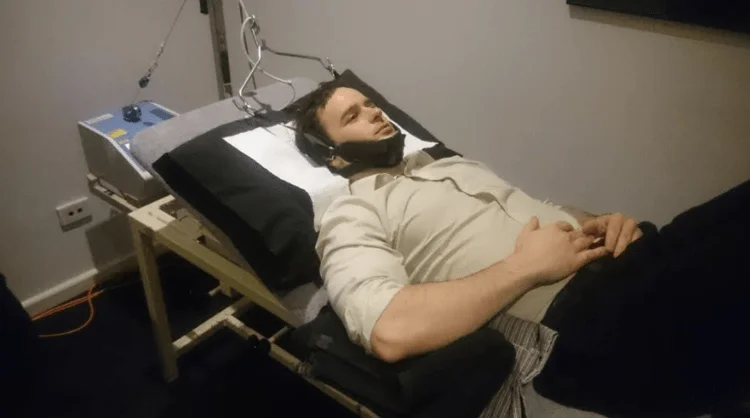Long Wave Diathermy (LWD)
What is a Long Wave Diathermy (LWD)?
Long Wave Diathermy (LWD) is a therapeutic technique utilized in physiotherapy and rehabilitation settings to alleviate pain and promote healing.
Long wave diathermy operates at frequencies ranging from 0.3 to 1MHz. The high-frequency current generates heat deep into the tissues, which lasts around 30 minutes.
Long wave diathermy generates oscillating electromagnetic fields (EMF) composed of both electrical and magnetic fields. The strength of these fields changes based on characteristics such as frequency and application qualities (e.g., capacitive electrodes).
Oscillating electric and magnetic fields generate heat in biological tissues by causing the fast alternating movement of ions, the rotation of bipolar molecules, and the deformation of Nonpolar molecules. Ion movement indicates a true current flow and happens naturally in electrolyte-rich tissues such as blood vessels and muscle.
Features of Long Wave Diathermy (LWD)
- Wide input voltage
- Microcontroller input
- The plastic-molded lightweight cabinet
- Touch-free absence keys
- LCD Display
- High efficiency and little maintenance.
The parameters of Long wave diathermy:
- Frequency: 1MHz
- Wavelength: 300m
- RF Frequency: 0.3MHz.
- Mode: Continuous, Pulse, and Automix.
- Pulse: 4 Hz, 8 Hz, and 12 Hz.
- Output Power: 0 to 15 to 25 watts.
- Timer: 0 to 20 min, up to 30 min
- Programmes 14
- Dimensions: length, weight, and height: 13 x 12 x 3.
- Weight: 2 kilogrammes
Therapeutic Effects of Long Wave Diathermy (LWD)
The LWD field’s action at the molecular level in fatty tissues causes blood vessels and muscle to heat, considerably, whereas adipose tissue heats vigorously because it is penetrated by tiny blood capillaries containing an electrolyte solution. The heat created is then kept due to the fat’s insulating characteristics, allowing for a high temperature to develop.
Fibrous tissue is not especially rich in blood vessels or fat and typically has a minor increase in temperature. In general, the tissue reaction to LWD is comparable to that of other kinds of heating, and the main indications and contraindications are the same as for surface heating.
Diathermy warms both deep and superficial layers of tissue, with superficial heating having the greatest effect on the skin and subcutaneous tissues. Diathermy often reduces pain, improves metabolic function, raises deep tissue temperature, and increases range of motion.
Heat activates the cutaneous thermos-receptors sufficiently to prevent pain from being transmitted to the spinal cord via the ‘pain-gate’ process. Heat has a therapeutic impact on muscular spasms by directly acting on the muscle spindles. The increase in conduction velocity found when peripheral nerves are burned by LWD might aid in the pain alleviation process.
Heating also relieves pain by stimulating Vasodilation and the stream from the damaged tissue of molecules implicated as pain mediators, including Bradykinin, serotonin, and Prostaglandins. The deep structures are most successfully heated by LWD with a 4mm penetration depth. As the temperature of the muscle spindle rises, the activity of the systems that provide information about static strain to the spinal cord diminishes.
At the same time, Golgi tendon organ production rises, which helps to avoid muscular overstretching. The aggravation of these inhibitory actions on the spinal cord’s anterior horn cells causes the affected muscle to relax. Furthermore, a decrease in gamma efferent activity generated by a reflex reaction to skin warmth reduces muscular spindle output and promotes relaxation. LWD is frequently used successfully in disorders involving pain and muscular spasms, such as bursitis, low back pain, arthrosis, and ligament injuries.
Procedures and applications of Long wave diathermy:
Generation:
During the generation step, a pulse signal with frequencies ranging from 0.3MHz to 1MHz is produced. This can be accomplished by utilizing a Microcontroller such as a microcontroller, or by combining circuits with their operating frequencies within the range. To generate the signal, use an analog circuit that includes a combined circuit with a maximum stable frequency of 2.7MHz.
Amplification:
Radiofrequency requires a power amplifier to increase the intensity and strength of the pulse signal, as a Microcontroller’s maximum amplitude is just 5 volts. Thus, an amplifier is required for the pulse signal to penetrate deep into the bodily tissues and create heat, thus inducing pain.
Modulation:
After amplification, the signal is modulated in amplitude using a Microcontroller to generate Waveforms such as burst, ramp, and triangle. Modulation may be accomplished using Microcontrollers such as the 8051 or Arduino.
Isolation:
Biomedical applications require an isolation transformer to protect patients from high-frequency current shocks. Long wave diathermy employs an isolation transformer signal with a frequency in the radio frequency range, involving the use of an alumina transformer capable of supporting radio frequency.
The resulting signal will be routed through an isolation transformer as a precaution for the patients. An isolation convert is a converter that distributes electrical power from a source of alternating current energy to equipment or devices while keeping the powered device apart from the power source, usually for safety reasons. Isolation transformers provide galvanic isolation and protection against electric shock. The secondary curving of an isolation transformer is not earthed, therefore it is floating or isolated.
Delivery Mode: Capacitive Electrodes
A Capacitive electrode is utilized to transmit the signal’s energy to the human body. Capacitive and inductive electrodes are the most frequent types of electrodes utilized in biological applications. Two Capacitive electrodes are utilized to transmit the signal into the patient’s body.
The active electrode sends the signal from the circuit into the human body, while the return electrode gathers the signal from the human body and sends it back to the circuit. The resulting signal can be modified in terms of amplitude, frequency, and/or phase to produce a variety of modulated patterns, including burst, ramp, triangle, PAM, PPM, and PWM.
The Capacitive mode enables the treatment of tissues with low resistance to current, with an emphasis on skin tissue, connective tissue, the blood circulatory system, and the lymphatics. To achieve the capacitance effect, current is given to the body through two electrodes: a tiny insulated active electrode and a non-insulated counter electrode placed on the opposite side of the body that has to be treated. In the delivery method that employs the compression system, a movement of electric charges ionic movement current is created inside the treated portion.
Patient:
Capacitive electrodes are used to deliver pain relief signals to the patient. The electrode placement chart must be examined while placing the electrodes since they cannot be placed in specific body areas, such as the brain, which would result in hazardous adverse effects on the affected body part. Long-wave diathermy provides benefits to people suffering from chronic diseases that cause discomfort. It is also used to reduce discomfort caused by kidney stones or sinusitis, as well as pelvic infections, neuralgia, and muscular Psoas.
Advantages of Long wave diathermy:
- greater penetration
- increased attention to the trigger points
- It can be used on ligaments and tendons that cover bone tissues.
- It enhances movement, lessens discomfort, and increases circulation.
- It allows for up to 4 cm of penetration and uses less electricity.
- In comparison to other modalities, longwave diathermy treatment is more precise and thorough, providing patients with relief much more quickly. It is based on the capacitor field.
The conditions needed for Long wave diathermy
- Tendinitis and ligament damage.
- Jumper knee and low backache.
- Myalgia
- Symptoms may include joint deformity
- edema
- arthritis, bursitis
- Piriformis syndrome
- Torticollis
- Impingement Pain Syndrome
- Frozen Shoulder
- Rotator Cuff Injury
- Hand Injury
Risk considerations for Longwave diathermy:
- Burning is the most common consequence associated with diathermy. When the long wave diathermy equipment is left in the same location for an extended period without proper movement, the heat might build up and burn depending on the temperature of the treatment.
- However, burns are frequently caused by a combination of various causes, including faulty equipment, inappropriate technique/method, and insufficient patient supervision.
- If you have metal implants such as pins, dental fillings, or electrodes, employing long wave diathermy to achieve radio wavelengths may put you in danger. This is because the metal can create heat, putting it at risk of burning.
- Conditions that enhance danger while undergoing diathermy include having a pacemaker or other implanted medical devices.
- You have a malignant tumor in the operated treatment region.
- If you have a fracture in the treatment region and are pregnant.
- If you have any of the disorders listed above, you should see a physical therapist before undergoing long-wave diathermy.
How many sessions are required for Longwave Therapy?
Long wave Therapy can be utilized for around 4 to 6 sessions. It will be used to reduce swelling in the tissues and relieve pain.
Side-effects of long-wave diathermy:
Skin burns: Prolonged or excessive exposure to long-wave diathermy can result in skin burns, particularly if the treatment intensity is too high or the skin is not appropriately covered throughout the operation.
Discomfort or pain: Some patients may feel discomfort or moderate pain during or after long-wave diathermy treatment, especially if the treatment region becomes extremely heated.
Skin irritation: In certain situations, the heat produced by long-wave diathermy can cause skin irritation or redness, which usually decreases on its own but may require topical therapies in extreme cases.
Hypersensitivity responses: Individuals may have hypersensitivity reactions to the materials used in long-wave diathermies, such as the coupling gel or electrodes.
Changes in blood pressure: Long-wave diathermy can cause transient changes in blood pressure, particularly if extensive regions of the body are treated or the treatment period is extended.
Risk of overheating: Patients with illnesses that affect their capacity to control body temperature, such as certain neurological disorders, may be more likely to overheat during long-wave diathermy.
Electrical dangers: Improper use or malfunction of long-wave diathermy equipment can result in electrical hazards, however, this risk is reduced when the equipment is operated appropriately by qualified people.
Contraindication of long wave diathermy:
Pregnancy: Long-wave diathermy should be avoided during pregnancy, particularly around the belly or pelvis, to avoid fetal damage.
Metal implants: Patients who have metal implants or foreign bodies in the treatment region should avoid long-wave diathermy since it might induce warmth and pain around the implants.
Pacemakers: People who have pacemakers or other implanted electronic devices should avoid long-wave diathermy since it may interfere with how these devices work.
Long-wave diathermy should be avoided in locations where there are known or suspected malignancies because it has the potential to encourage tumor development or interfere with cancer therapy.
Acute inflammatory conditions: Long-wave diathermy should not be used on acutely inflamed regions or active infections since it might worsen inflammation or transmit infection.
Impaired sensation: Patients with reduced feeling or changed pain perception may not be appropriate candidates for long-wave diathermy since they will be unable to offer feedback on the severity of the therapy.
These contraindications emphasize the significance of evaluating each patient individually, taking into account their medical history, present state, and any possible dangers, before giving long-wave diathermy or any other medical treatment.
Precaution of long-wave diathermy:
Long wave diathermy is a type of physical treatment in which electromagnetic waves produce heat in tissues. Here are some precautions to consider while utilizing long-wave diathermy:
Professional Supervision: Trained healthcare professionals should deliver long-wave diathermy to guarantee proper settings and safe use.
Patient Assessment: Before beginning therapy, review the patient’s medical history, current health state, and any contraindications to diathermy.
Skin Protection: To avoid burns, cover sensitive regions of the skin, such as bony prominences and areas with diminished sensitivity, with a towel or gel.
Temperature Monitoring: To avoid overheating or burns, measure the skin’s temperature regularly throughout treatment. Adjust the intensity and duration of diathermy accordingly.
Pregnancy Precautions: Do not use long wave diathermy on pregnant patients’ abdomens or pelvises unless expressly directed by a healthcare practitioner.
Metal Objects: Remove any metal objects, such as jewelry or clothing with metal fasteners, from the treatment area to avoid burns or electromagnetic interference.
implanted Devices: When treating patients with implanted devices such as pacemakers or metal implants, use caution since long wave diathermy might interfere.
Contact: Maintain open lines of contact with the patient during the therapy to evaluate their comfort level and address any concerns or unpleasant responses immediately.
Randomized controlled study effectiveness of Longwave diathermy for neck pain:
The patient was separated into two groups: the first would exercise and stretch, while the second would undergo long wave diathermy.
The patient in the first group does the initial neck exercises, which include neck range of motion exercises, neck isometrics exercises for deep neck muscles, and Trapezius and Levator scapula stretching. Every exercise should be repeated 10 times with a 10-second hold time three days a week for two weeks. The neck isometric exercises include six movements: cervical flexion, cervical extension, right and left lateral flexion, and right and left rotation.
For cervical flexion movement, the patient was instructed to tilt the neck forward slightly and place the Volar aspect of both hands on the forehead. The therapist should next ask to force the patient’s head into their hands while resisting the movement with their own hands.
For cervical extension movement, the patients were instructed to posture their necks straight. The therapist should next instruct the patient to place the volar aspect of both hands on the back of the head and press the neck against both hands while resisting the action with both hands.
The starting position for lateral flexion, right or left, was the same: neck straight. The patients should then be told to place the Volar aspect of one hand on the same side of their head and push their head into the Volar aspect of the hand. The hand simultaneously opposes the action.
The starting position for right and left rotation was identical to that of lateral flexion. The patients were then instructed to place the Palmer aspect of one hand on the same side of the head and turn it to that side despite the hand’s resistance.
Stretching after completing all of the neck exercises should help relax some muscles.
The patient was told to stretch the upper Trapezius muscle with one hand by pulling the head in the opposite direction while the other arm extended downwards. Patients were told to stretch only when they felt muscle elongation and not if it hurt.
The levator scapulae muscle was stretched by holding the opposite side of the head with one hand and pulling the chin towards the Axilla. The Levator scapula was stretched by putting one hand on the opposite side of the head and bringing the chin towards the armpit. To properly stretch the muscle, the Contralateral arm was dragged upwards along the wall, forcing the shoulder blade to rotate upward.
The Second Set of Patients should utilize the Long Wave Diathermy. Over two weeks, the drug was given three times each week. Long wave diathermy was employed for 10 minutes in continuous mode at a frequency of 1MHz.
The patient was asked to sit in the chair while holding an inactive electrode. The therapist stood behind the patient, leaving the treatment area widely exposed. Before commencing therapy, the patient was told to remove any jewelry and accessories that encircled the neck area.
The machine LWD was then turned on, and the active electrode was moved in a circular motion over the sore location. Patients in both groups were instructed to repeat the neck exercises at home. Patients were told to avoid activities that required extended neck flexion, to maintain appropriate posture, and to avoid sleeping with heavy pillows. At the end of the second week, all participants had their outcome measures assessed. A follow-up examination of outcome measures was also conducted.
The conclusion of the study:
The goal is to see how long-wave diathermy affects neck pain, disability, and range of motion in patients suffering from neck discomfort. When pre and post-intervention readings were compared, the first group of patients showed a substantial improvement in all end measures such as pain, neck ROM, and neck disability, except neck side flexion to the right.
In the second group, individuals who got LWD as an intervention in addition to neck exercises, the results showed a substantial improvement in all outcome measures when pre and post-intervention readings were compared. Furthermore, there was a significant difference between pre and post-follow-up measurements, indicating that the improvement attained by the offered intervention was sustained in the subsequent time.
The group comparison revealed that the long wave diathermy group improved more than the first group in terms of VAS, NDI, and neck extension range of motion, but there was no difference in neck flexion, side flexion, or rotation to both sides.
The current study’s findings are consistent with a study conducted on individuals suffering from upper Trapezius muscular spasms, which revealed that there was an improvement in spasms after 6 days of continuous Longwave Diathermy treatment.
The use of LWD on patients with plantar fasciitis was combined with long-wave diathermy, and the findings showed that there was a reduction in discomfort and improvement in foot functions when the patient used long-wave diathermy three times per week for four weeks.
The non-significant change might be due to a single application of long-wave diathermy. The reduction in pain in patients who got the LWD might be referable to the activation of cutaneous thermoreceptors, which produce the creation of heat and obstruct pain communication when it enters the linked area of the spinal cord via the pain gate mechanism. Heat increases the Nerve Conduction Velocity of the peripheral nerves, which aids the pain relief process even more. The heat also stimulates microcirculation and metabolism. Reduced pain correlates to less neck impairment and enhanced functionality.
There is a link between endurance capacity cervical muscular strength and neck discomfort. Exercises such as isometrics and stretching enhance muscle strength, restore damaged tissue, and assist in maintaining regular daily activities. Static stretching exercises helped decrease discomfort and enhance the range of motion in individuals with neck pain. The lack of a significant difference in neck range of motion in other directions between the two groups might be attributed to age differences in both groups, as well as the short-term use of long-wave diathermy.
FAQs
What is the principle behind long-wave diathermy?
Longwave diathermy generates oscillating electromagnetic fields composed of electrical and magnetic fields. The intensity of these fields varies depending on numerous parameters, including the unit’s frequency and the applicator’s properties, such as capacitive electrodes.
What is the role of long-wave diathermy in physical therapy?
Long wave diathermy is the therapeutic use of heat to the body to treat a variety of musculoskeletal problems, including muscular strain and low back pain, which are frequent among athletes.
What cells do long wave diathermy damage?
Long Wave Diathermy is a therapy that employs an electrical current to break down cancer cells.
How long does long-wave diathermy normally last?
The operation normally takes 5-10 minutes.
Long wave diathermy is used for what?
Longwave diathermy is a physiotherapy treatment for tendinitis, myalgia, arthritis, lower back pain, and ligament injury.
What other names does long wave diathermy go by?
Furthermore, long-wave diathermy (LWD), also known as capacitive and resistive electric transfer treatment, has lately attracted a lot of therapeutic attention in the sports world.
What is the frequency of long-wave diathermy?
Longwave diathermy operates at frequencies ranging from 0.3 to 1 MHZ with a wavelength of 300m.
References
- Mandaliya, D. (2023, December 13). Long wave diathermy – Procedure, Indication – Mobile Physio. Mobile Physiotherapy Clinic. https://mobilephysiotherapyclinic.in/long-wave-diathermy/
- Dhameliya, N. (2023, January 2). LONG-WAVE DIATHERMY IS USED IN PHYSIOTHERAPY. Samarpan Physiotherapy Clinic. https://samarpanphysioclinic.com/long-wave-diathermy-used-in-physiotherapy/
- V. (2022, August 22). Longwave Diathermy. Mobility Physiotherapy Clinic. https://mobilephysiotherapyclinic.net/long-wave-diathermy/

